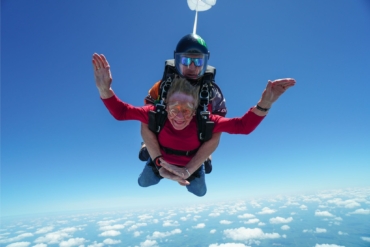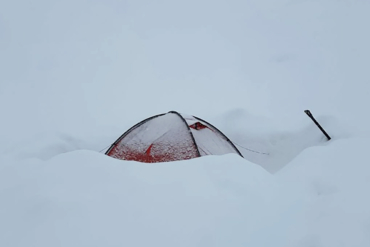Night Orienteering
By STEPHEN REGENOLD
published October 23, 2008
The sharp beam of an L.E.D. headlamp cuts clean through the night air as Stanley Barton runs south on a rutted dirt trail. Map in hand, compass ready, Barton navigates to a thick stand of brush, rechecking his position on the page before diving in.
Sticks snap. Branches break. Barton wades in the tangle, clawing and moving on through thorns and walls of sticks intertwined and thick as wicker.
“Keep heading south,” Barton yells. “There’s a trail beyond this mess.”
Two-dozen bobbing headlamps dot the forested hills beyond, a stampede of nocturnal athletes on Barton’s tail. Shouts echo off in the still woods. Barton and his teammate are in third place, running with all they’ve got, straining to find the next control point flag.
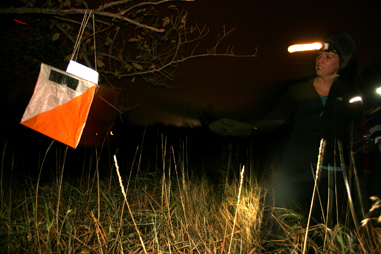
Racer approaching control flag
It’s a dark Friday night in late September last fall. The race — the first of three night Adventure Runs organized by the Minnesota Orienteering Club — follows a 4.7-kilometer course through the trees and open fields of Hyland Lake Park Reserve in Bloomington, Minn. Eleven small flags lay hiding in the woods.
Orienteering is a Nordic sport that puts runners on backcountry courses in search of hidden flags. A detailed map reveals the lay of the land; a compass points direction. You pick the route through the woods, stamping a punch card to imprint at each flag.
But orienteering is usually done in the daylight.
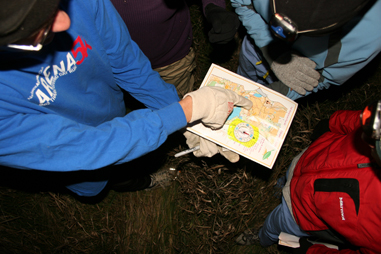
Team plotting a course on a night-O
“Night certainly adds another dimension to the sport,” said Pete Curtis, an orienteer from St. Paul. The hills, lakes and other large features that are obvious in the sunlight may not be visible in the dark. Headlamps help, but any long view of the land is absent at night.
Instead, night orienteering — also called “night-O” — requires runners to follow the minutia of the land, tracking vegetation boundaries, bouncing along lakeshores, hiking gullies, and winding down trails to find flags hidden on hilltops, near swamps, or in pits, reentrants and other subtle features.
For Curtis, a software architect who participates in more than a dozen orienteering events a year, night races are more difficult, though not exponentially so. “Just stay on the map, know where you’re at, and you’ll do OK.”
Night scene
Nationally, nighttime races are rare. “Night orienteering is not a standard form of the sport,” said Robin Shannonhouse, executive director of the United States Orienteering Federation (USOF), which claims 2,200 dues-paying members. She said some orienteering clubs hold one night-O a year “just for fun,” but USOF-sanctioned competitions at night do not exist.
Shannonhouse estimates there are about 30 night orienteering events held each year nationwide.
In Scandinavia, where orienteering is a mainstream sport, night-O events are common. The Jukola relay, a Finnish race held annually since 1949, attracts more than 1,000 teams to orienteer from 11 p.m. on through the whole night.
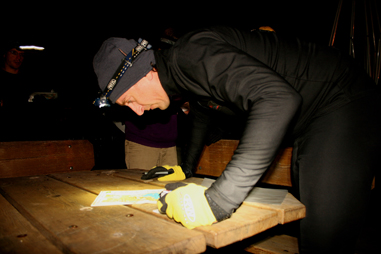
Racer studying the map before dashing into the dark
Races like the Adventure Run at Hyland Reserve take only an hour for top teams to complete. Less experienced navigators may take twice that long, and many never find all the flags.
“We got lost for a little while,” said Angie Balfanz, a first-time orienteer lured into the Adventure Run series by a friend. “The whole experience was different than anything I’ve ever done before.”
Molly Moilanen, an adventure racer, said the sport helped her conquer a fear of the dark. “I would have never gone out in the woods alone at night before,” she said. “Now it’s fun!”
For Stanley Barton — who maintained the pace during the September event to take third place overall — running off trail at night is invigorating. He describes the woods as quiet and strange, a moon above, black forest all around, shadows crisscrossing in headlamp beams on the ground ahead. “The whole scene is pretty surreal,” he said.
(Stephen Regenold writes The Gear Junkie column for eleven U.S. newspapers; see www.THEGEARJUNKIE.com for video gear reviews, a daily blog, and an archive of Regenold’s work.)


